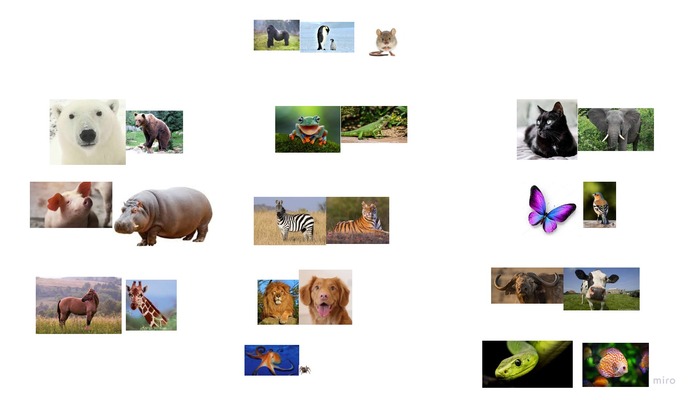
Ingredients
- A set of pictures of animals, flashcards or on Miro. That’s it.
Procedures
- Revise the vocabulary and ensure that all the cards are displayed at the same time for the kids to be aware of all the options
- Model by choosing a pair of animals and putting these cards aside and justifying your choice. With my pre-primary kids, I like to use the first person statements (I’ve got 4 legs etc) as this is what we do with the younger kids (to enable the kids to talk about themselves and the animals without having to introduce the additional structures and to keep it coherent with the songs that we use ie Little bird or As quiet as a mouse). I also tend to vocalise the language ie I’ve got 4 legs (for the cat), I’ve got 4 legs (for the elephant).
- Invite the kids to take turns to make their own pairs and to describe the rationale behind it.

Why we like it
- An opportunity for the kids to use and to develop the higher order thinking skills in the EFL context
- The students are in charge of what they want to talk about and what they can talk about. It is appropriate for mixed-ability groups.
- Little or no preparation as the flashcards are already there, the physical cards in the offline classroom or the set of pictures on Miro which, once prepared, can be doubled easily and used only for that activity.
- A great variety of structures that can be revised and some opportunity to learn the new ones as the kids might have the ideas that they cannot express in English yet and this game can be the springboard which will help to introduce these. If the teacher speaks the kids’ L1.
- Lots of opportunities for adaptation and using them with different sets of words such as toys, fruit, food, transport and, naturally, the relevant structures. I like to start this game with animals because of the range of easy structures that even the very young beginner students can use in order to complete task and because of the variety of topics that can be included (the colours, the number of legs, what animals can do, what they eat, where they live etc)
- The level of challege can also be easily adapted, for example, the set of cards can include only 8 items or the teacher can focus on putting the animals into pairs basen only on the colours or the size which are probably the two most achievable categories, both cognitively and linguistically.
- This is a neverending activity because the cards and the animals can be grouped and re-grouped over and over again to let the students create new and less obvious links between the items. Conversly, it can be shortend as needs be.
- As regards the interaction patterns, this activity can be used with groups, with kids working together, at least in the beginning, or in pairs if we have the appropriate number of sets of cards as well as with 1-1 students, both online and offline.
- There is also some potential for adaptation in the area of materials. The most obvious choice are the flashcards, the mini-flashcards or the Miro board. The teacher can also create a handout with the animals pictures and/or names which the students can colour-code as they are putting them in pairs. This might be a good solution for the kids to work in pairs in the offline classroom.
- Last but not least, this activity is an opportunity for the kids to develop the listening skills (as they want to find out the justification for their peers’ choices) and the speaking skills (as they want to present their own reasoning, too). I simply love to observe how my students start with the simplest and most obvious connections and how they venture out into more and more creative ones.
Happy teaching!